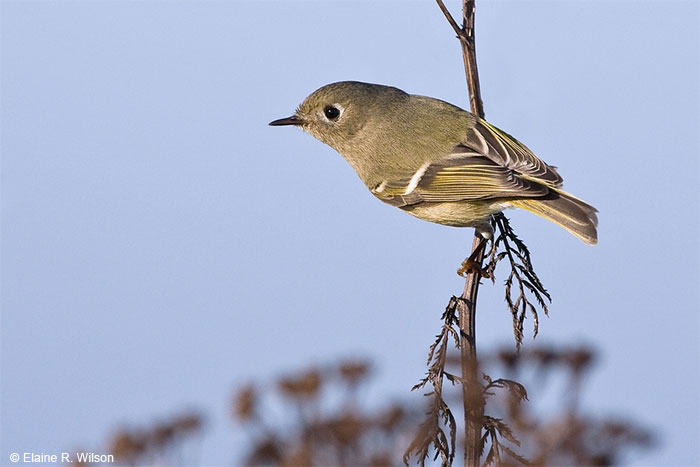Ruby-crowned Kinglets (Corthylio calendula) are one of the smallest songbirds that can be found throughout North America.
Despite their small size, they can produce beautiful, loud, and complex songs that include a variety of whistles, warbles, and chatters.
They are known for their distinctive bright red crown, which is often hidden from view, and for the habit of flicking their wings nervously.
On this page
Identification
Ruby-crowned Kinglets are tiny olive-buff songbirds with large heads but small and thin tails and bills. The birds measure 3.5-4.3 inches long, weigh around 0.2-0.3 ounces, and have a wingspan of 6.3-7.1 inches. Their bills and eyes are black, and their feet are dark brown.
Adult Ruby-crowned Kinglets are grayish-olive above and pale yellowish-green below. Their dark wings have light green edgings and a white wingbar. They have a dark tail with light green edgings and a broken white eyering.
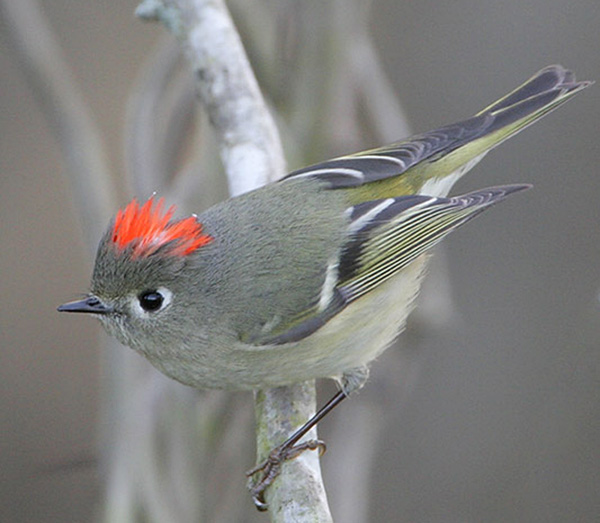
Photograph © Greg Lavaty.
Male Ruby-crowned Kinglets also have a bright red crown that they raise when they’re excited or nervous. Otherwise, it is concealed by surrounding olive-toned feathers and is hard to spot. In rare cases, the crown may also be orange, yellow, or absent altogether.
Female Ruby-crowned Kinglets look identical to males except that they lack the bright-colored crown. Juvenile Ruby-crowned Kinglets are quite similar to adults. However, their upperparts are more brownish-gray, their underparts are light grayish, and they lack the red crown.
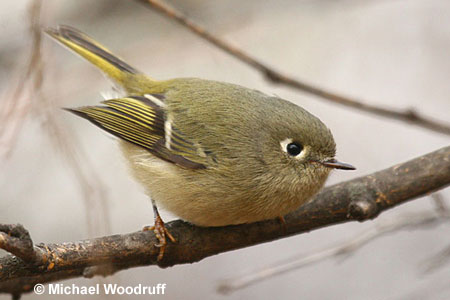
Female Ruby-crowned Kinglet
Ruby-crowned Kinglets have various types of songs and calls. Males sing a loud and twittering song that starts with soft, high-pitched whistles and accelerates into lower-pitched warbles and chatters. T
he song lasts for about 5 seconds and they mainly sing it during the breeding season, but may also sing it on the wintering grounds and during migration.
Their most common call is a harsh alarm call consisting of two fast scolding notes. They may also give a longer series of chattering scolds.
Food
Ruby-crowned Kinglet’s diet consists of both animal and plant matter and varies very little from season to season. They eat whatever is available but focus primarily on insects year-round. During the winter, their diet may include more plant matter.
The animal part of their diet includes insects, bugs, beetles, leafhoppers, flies, wasps, caterpillars, spiders, ants, moths, pseudoscorpions, and insect eggs. Fruit, various seeds, vegetable matter, and berries such as elderberries make up the plant part of their diet. They may occasionally drink tree sap.
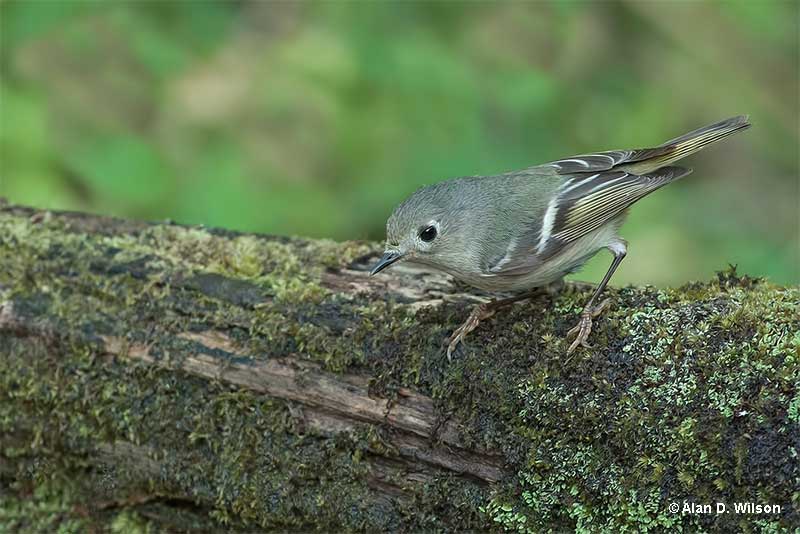
© Alan D. Wilson
Ruby-crowned Kinglets forage at all levels but prefer to do so in the foliage of high trees. You may see them forage high in tree foliage, hanging from twigs, looking under the leaves, or hovering to peck insects from branches.
They may also search around in the low brush, hopping from branch to branch and snatching up prey as they go or flying around to catch insects mid-air. You can recognize them by their constant wing-flicking, which gives them a nervous demeanor.
Nesting and Eggs
Although monogamous, Ruby-crowned Kinglets only mate for one breeding season. In courtship, the male approaches the female and hops around her from branch to branch while singing, sometimes crouching, raising his red crest, and fluttering his wings. The female flutters her wings in response.
Ruby-crowned Kinglets usually nest in conifers, most often spruce, on average 40 feet but as high as 90-100 feet above the ground. They build their nests either near the trunk or attach them to small hanging twigs. In both cases, the nest is well protected and hidden by foliage, making it very hard to spot.
The female Ruby-crowned Kinglet builds the small nest and gathers the material on her own. The outer structure is constructed of twigs, rootlets, moss, lichens, bark strips, conifer needles, grasses, and spider silk whereas the inside of the nest is lined with animal fur, feathers, and fine plant material. Thanks to the spider silk, the nest is able to expand a bit as the brood grows bigger.
Ruby-crowned Kinglets have only one brood per year with 5-12, most often 7-8 eggs in a clutch. The eggs measure 0.5-0.6 inches long and 0.4-0.5 inches wide. They are whitish to pale tan with brownish spots near the larger end.
The mother bird incubates them alone for 12-14 days. Both parents take care of the younglings until they leave the nest at about 16-18 days after hatching.
Current Situation
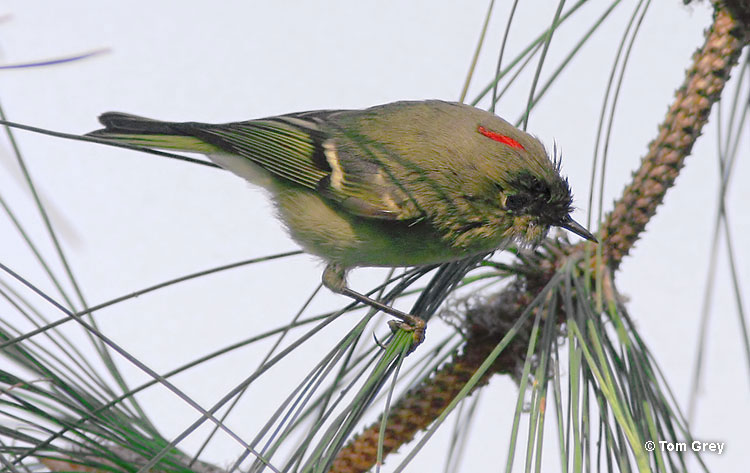
© Tom Grey
Ruby-crowned Kinglets range throughout North America and Mexico. Their breeding range covers most of Canada and Alaska and extends into the northern parts of the Great Lakes and northwestern parts of the United States.
They’re short-distance migrants and fly to the southwestern and southern United States and as far as Mexico for the winter. Some populations in the Rocky Mountains are year-round residents and just move to lower elevations during colder times.
Ruby-crowned Kinglets inhabit various habitats from forests to brushes and thickets to more open areas such as meadows. They breed in coniferous forests with trees such as fir, spruce, and pine.
During migration and winter, they can be seen in more diverse habitats such as deciduous and mixed woods, streamside thickets, mesquite brush, meadows, mountain shrubs, and more.
Ruby-crowned Kinglets are listed as a species of least concern on the IUCN Red List. They have an increasing population of 100 million mature individuals. Only logging and wildfires pose a threat to their population.
Facts
- The Ruby-crowned Kinglet has three subspecies. One of them, Corthylio calendula obscurus, only inhabits one single island called Guadalupe Island that’s located off the coast of northwestern Mexico. This subspecies is most likely extinct since it hasn’t been seen in over 60 years.
- These birds lay an impressive number of eggs for their tiny size. One clutch can contain up to 12 eggs and all together they may weigh as much as the female bird.
- The oldest known Ruby-crowned Kinglet lived to be 8 years and 8 months old. However, their average lifespan is probably lower.
- Ruby-crowned Kinglets are very active and look nervous because of their constant wing-flicking. Despite this habit, they only burn 10 kilocalories per day.
- Ruby-crowned Kinglet’s former scientific name was Regulus calendula. However, due to its differences from the other members of the Regulidae family, it was assigned its own genus called Corthylio.
Similar Species
Although Ruby-crowned Kinglets have rather unique crimson-red crests, you can still mistake them for another bird. We have introduced two of them and brought out how to know which is which.
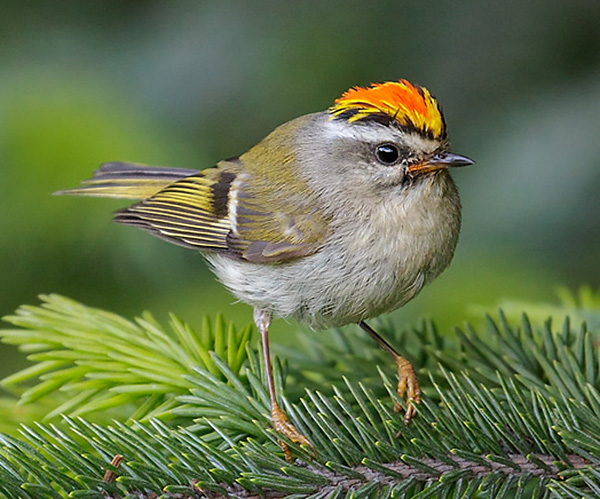
Golden-crowned Kinglet. Photograph © Glenn Bartley.
Overall, Ruby-crowned and Golden-crowned Kinglets have the same pale olive-green plumage.
However, Golden-crowned Kinglets have a yellow crown instead of a red one and their crown is surrounded by black stripes.
Golden-crowned Kinglets also have a white “eyebrow” whereas Ruby-crowned Kinglets have a broken white eyering.
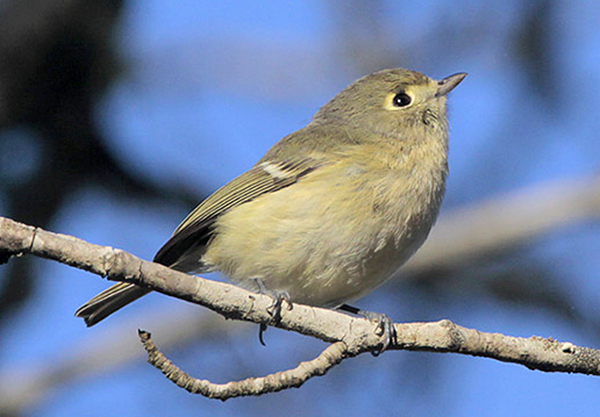
Hutton’s Vireo
Similarly, Hutton’s Vireos have very similar olive-green plumage and wings.
However, their wings don’t have a black bar below the white one as Ruby-crowned Kinglets have, and they don’t have a red crown either.
Their beaks are also a bit lighter-colored and they are a bit larger and slower.
Frequently Asked Questions
What is the difference between a Golden and Ruby-crowned Kinglet?
Golden-crowned Kinglets have a yellow crest surrounded by black stripes, whereas Ruby-crowned Kinglets have a crimson-red crest.
Are Ruby-crowned Kinglets rare?
Ruby-crowned Kinglets are widespread and common throughout their range.
What is the habitat of a Ruby-crowned Kinglet?
Ruby-crowned Kinglet’s main habitat is forest. They breed in coniferous forests, but during migration and winter can also be seen in other habitats, such as mixed and deciduous forests, brush, streamside thickets, and meadows.
What does the Ruby-crowned Kinglet symbolize?
Ruby-crowned Kinglets symbolize hope, perseverance, fearlessness, and renewal.

